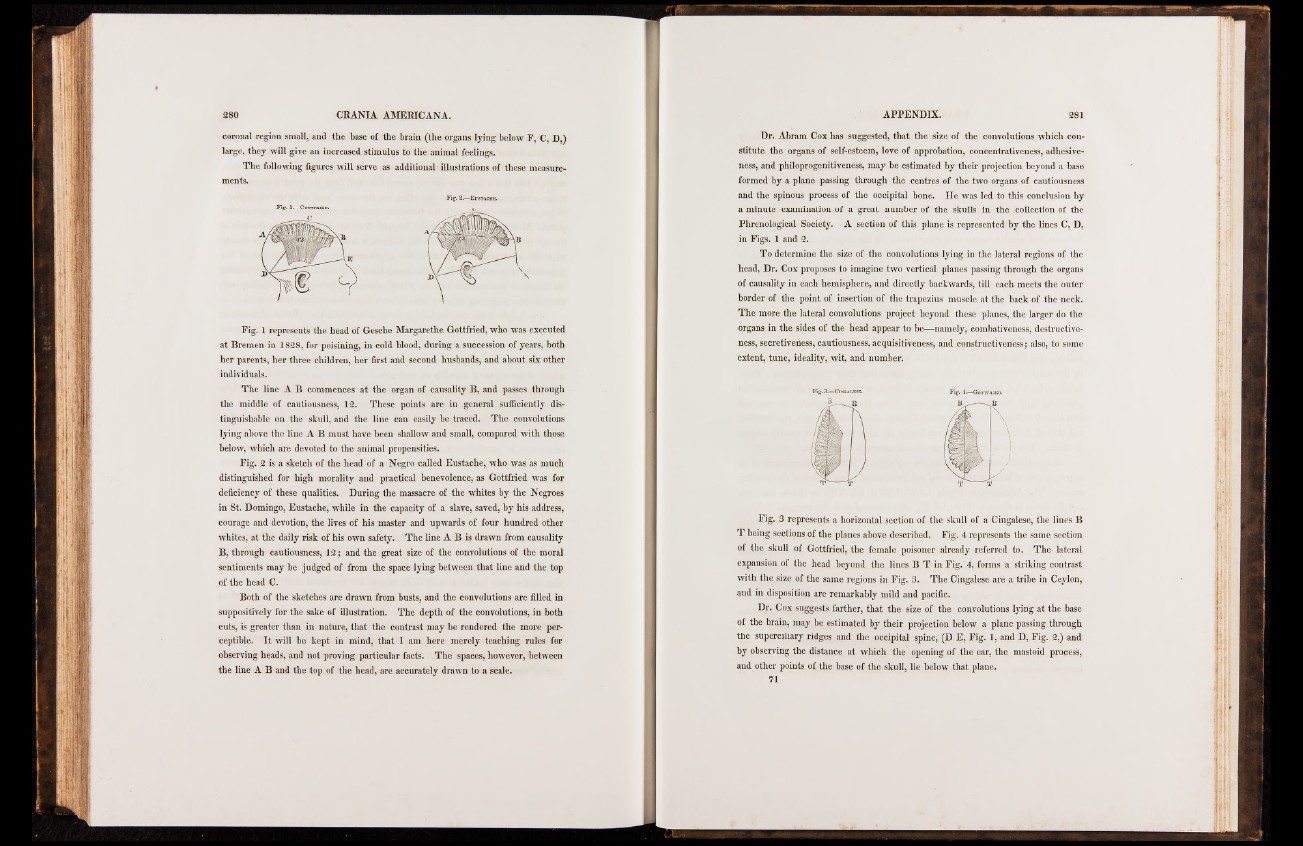
coronal region small, and the base of the brain (the organs lying below F, C, D,)
large, they will give an increased stimulus to the animal feelings.
The following figures will serve as additional illustrations of these measurements.
Fig. 1 represents the head of Gesche Margarethe Gottfried, who was executed
at Bremen in 1828, for poisining, in cold blood, during a succession of years, both
her parents, her three children, her first and second husbands, and about six other
individuals.
The line A B commences at the organ of causality B, and passes through
the middle of cautiousness, 12. These points are in general sufficiently distinguishable
on the skull, and the line can easily be traced. The convolutions
lying above the line A B must have been shallow and small, compared with those
below, which are devoted to the animal propensities.
Fig. 2 is a sketch of the head of a Negro called Eustache, who was as much
distinguished for high morality and practical benevolence, as Gottfried was for
deficiency of these qualities. During the massacre of the whites by the Negroes
in St. Domingo, Eustache, while in the capacity of a slave, saved, by his address,
courage and devotion, the lives of his master and upwards of four hundred other
whites, at the daily risk of his own safety. The line A B is drawn from causality
B, through cautiousness, 12; and the great size of the convolutions of the moral
sentiments may be judged of from the space lying between that line and the top
of the head C.
Both of the sketches are drawn from busts, and the convolutions are filled in
suppositively for the sake of illustration. The depth of the convolutions, in both
cuts, is greater than in nature, that the contrast may be rendered the more perceptible.
It will be kept in mind, that I am here merely teaching rules for
observing heads, and not proving particular facts. The spaces, however, between
the line A B and the top of the head, are accurately drawn to a scale.
Dr. Abram Cox has suggested, that the size of the convolutions which constitute
the organs of self-esteem, love of approbation, concentrativeness, adhesiveness,
and philoprogenitiveness, may be estimated by their projection beyond a base
formed by a plane passing through the centres of the two organs of cautiousness
and the spinous process of the occipital bone. He was led to this conclusion by
a minute examination of a great number of the skulls in the collection of the
Phrenological Society. A section of this plane is represented by the lines C, D,
in Figs. I and 2.
To determine the size of the convolutions lying in the lateral regions of the
head, Dr. Cox proposes to imagine two vertical planes passing through the organs
of causality in each hemisphere, and directly backwards, till each meets the outer
border of the point of insertion of the trapezius muscle at the back of the neck.
The more the lateral convolutions project beyond these planes, the larger do the
organs in the sides of the head appear to be—namely, combativeness, destructiveness,
secretiveness, cautiousness, acquisitiveness, and constructiveness; also, to some
extent, tune, ideality, wit, and number.
Fig. 3 represents a horizontal section of the skull of a Cingalese, the lines B
T being sections of the planes above described. Fig. 4 represents the same section
of the skull of Gottfried, the female poisoner already referred to. The lateral
expansion of the head beyond the lines B T in Fig. 4, forms a striking contrast
with the size of the same regions in Fig. 3. The Cingalese are a tribe in Ceylon,
and in disposition are remarkably mild and pacific.
Dr. Cox suggests farther, that the size of the convolutions lying at the base
of the brain, may be estimated by their projection below a plane passing through
the superciliary ridges and the occipital spine, (D E, Fig. 1, and D, Fig. 2,) and
by observing the distance at which the opening of the ear, the mastoid process,
and other points of the base of the skull, lie below that plane.
71